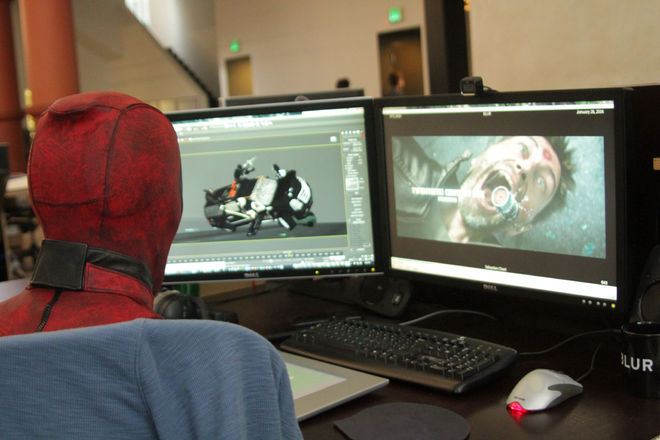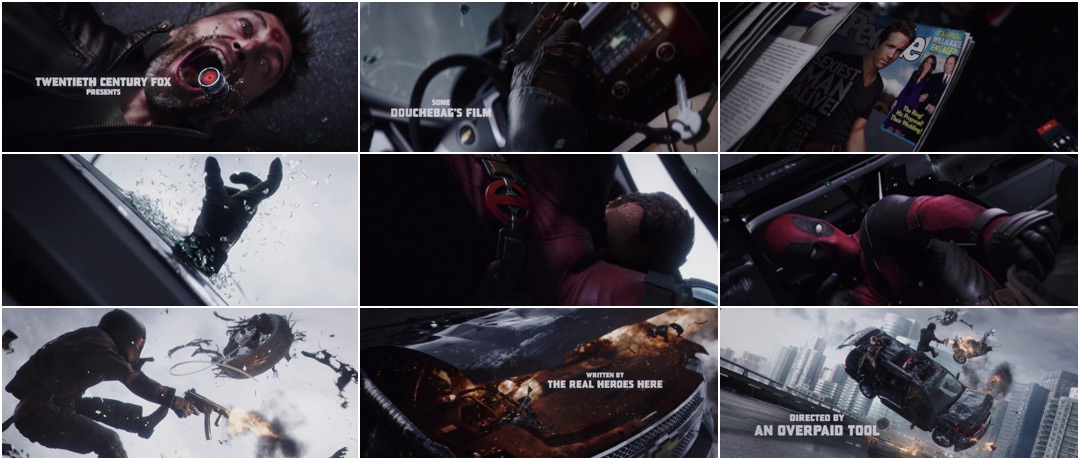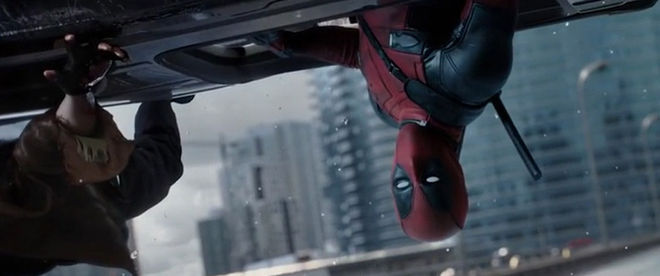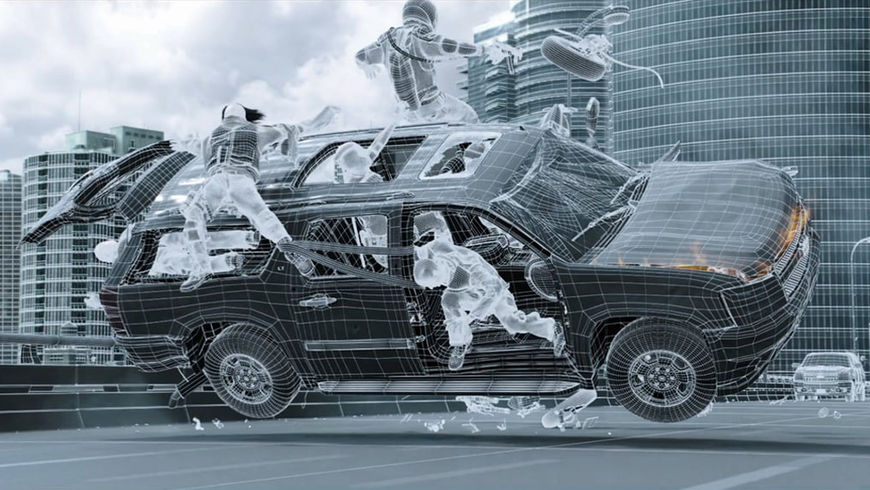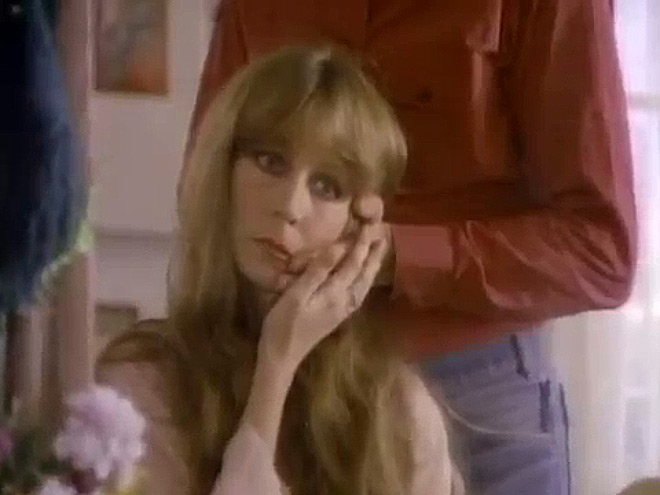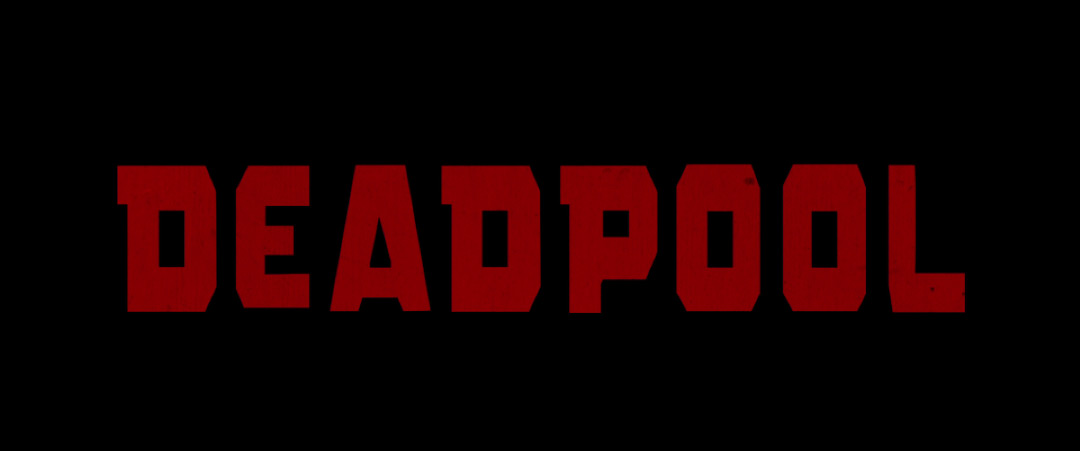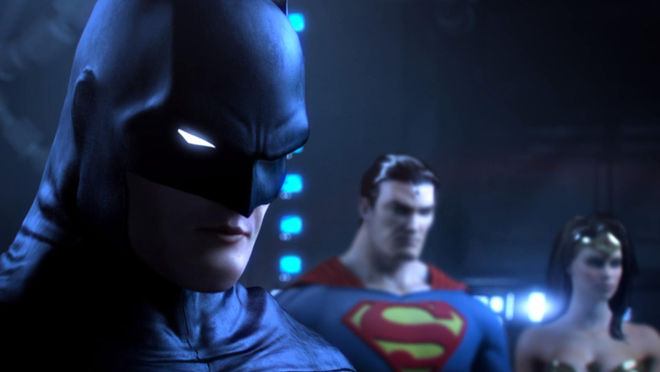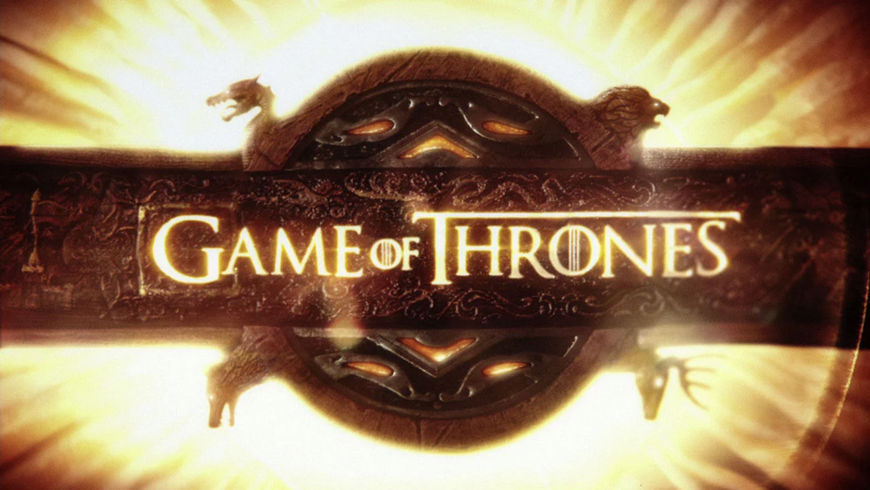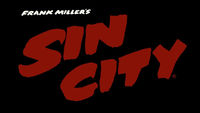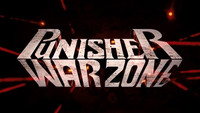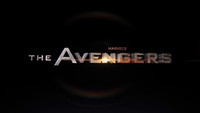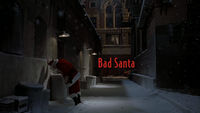The opening notes of Juice Newton’s adult contemporary classic “Angel of the Morning” drown out what are sure to be the final screams of some extremely unlucky hired goons. Here, frozen in time, in the back seat of an exploding Cadillac Escalade, a hyper-violent tableau takes shape. In what can only be described as some unholy marriage of the Three Stooges and a Michael Bay movie, battered bodies fly in all directions, engulfed in a shower of spit, blood, and broken glass. Guns are fired. Eyes are gouged. Tea is bagged. This is Deadpool… or rather it’s our introduction to Deadpool, the masked mutant in the middle of all that death and debris – the guy deftly executing the wedgie to end all wedgies.
From the moment the first credit appears on screen, it’s clear the Deadpool opening title sequence is designed for one thing and one thing only: to gleefully take the piss out of the entire proceedings. In a world where star Ryan Reynolds is at once People’s 2010 “Sexiest Man Alive” and Wade Wilson – the chimichanga-craving Marvel Comics antihero with a penchant for breaking the fourth wall – it’s appropriate for Blur Studio’s opening to acknowledge the fact that it is a title sequence in a movie. Full of sly (and not-so-sly) nods to comic book fans and self-reflexive title cards that say what we’re all really thinking, there is no way to come away from the Deadpool opening sequence without knowing full well what you’re about to get into.
Why is Deadpool in this ridiculous predicament? Don't worry, he'll explain.
A discussion with Director TIM MILLER and Layout Supervisor FRANCK BALSON of Blur Studio.
First of all, congratulations on the amazing success of the film. What’s the mood at Blur like right now?
Tim: Everything is very positive! For me it’s a little overwhelming – like the “hard to hold in your mind” kind of overwhelming. It was literally so many years of trying, so I’m still in that mode of being defeated constantly. I keep forgetting I won this one.
If it had opened at $50 million I would have felt like I made a good movie and people went to see it. But $150 million? That’s like being struck by lightning – you can’t control that sort of thing. We hit a moment. But it feels good. I’ll take the win.
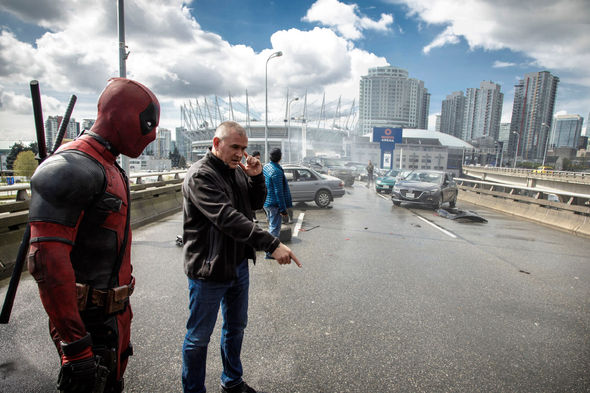
Director Tim Miller blocks out a scene with Ryan Reynolds on location in Vancouver
So when we first reached out to the team last year, you mentioned that you had a great idea for the Deadpool opening sequence but that it was ultimately a question of budget. Where was the development of the title sequence at that point?
Franck: It wasn’t much. Just the temp version I had done in a few days.
Tim: We originally had to cut the title sequence from the visual effects budget. We just couldn’t afford it. But before we left for Vancouver, Franck had done an animatic version of the titles and it was nice to have something that we could say, “Here’s what we’d like to do” even though we had cut it from the original budget.
There’s always things that get cut for budget reasons, it’s a process. There’s always a list of things we’d like to do if we could find savings somewhere else.
So Franck tell us about the genesis of that early version. Was it in the script?
Franck: Yeah, it was in the script – at least the very first one that I read. It was actually pretty clear: It was this frozen moment with one of the thugs and the lighter coming out of his mouth. It was basically saying these guys are fighting in the car and we’re moving across this macro world seeing all these pieces of debris. Then we reveal that Deadpool is in there and it switches back into real-time, and into the movie.
Deadpool red band trailer
Franck: It ties into the big action scene at the beginning where Deadpool jumps into the car and you have this whole freeway sequence and car chase. I mostly started working on the title sequence because we were going to lead into this at some point anyways. So we needed to figure out where these characters were going to be in the car and what this static moment was going to look like. It was easier to define that first, figure out how to get the characters in that position, and work backwards from there, rather than doing the whole freeway sequence and then realizing that the characters don’t look right or that we couldn’t get a framing that we liked.
So we just started posing the characters, not even working on the camera moves. I did a really quick pass of what the titles could be, but then we put it on hold because for budget reasons. Once it was greenlit, we started working on the title sequence in October [2015] and we had a couple of months to complete it.
The funny part was that, at the time we started the title sequence, no one had been cast except Ryan Reynolds. So because it was a title sequence the only names that were in there were Tim’s – which he asked me to remove really quickly – and Ryan’s. But we needed placeholders for the rest. I’d read the script and knew there was going to be a “hot chick,” a “young girl,” a “bad guy,” and so forth. That was the only thing we could put in there because we didn’t know who else was going to be in it.
So one day Tim asked me if I had a version of sequence and I was like, “Yeah, but it’s not finished.” But then I showed it to him and he liked it.
Original title sequence test previs designed by Franck Balson
Tim: The generic names just struck me as very funny. I shared it with Ryan and the writers, Rhett Reese and Paul Wernick, and they all loved it. The writers obviously loved the sequence since it was their concept, but they especially liked the idea of fake titles – the whole movie is very meta and that was super-meta. It wasn’t originally supposed to be that, but it seemed to fit so well just decided to keep it that way.
Well, thank you for recognizing writers as the real heroes out there! [laughs]
Tim: [laughs] Oh yeah, loved that one, very clever and it really puts the writers in the movie in a very fourth-wall-breaking sort of way!

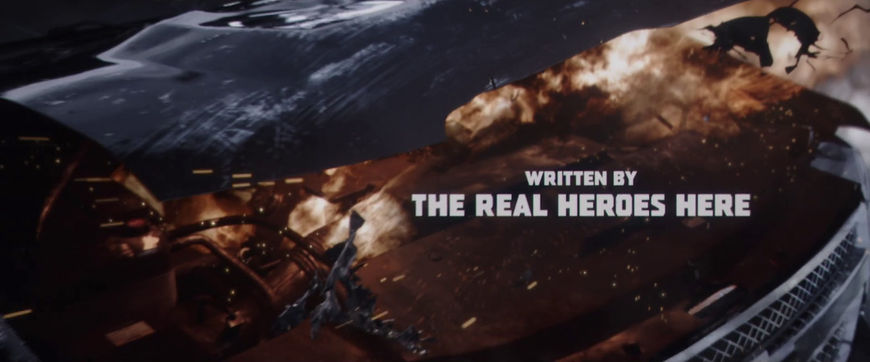
But aren’t there guild rules and contractual obligations that should have prevented you from doing something like that? Did the meta credits create any issues?
Tim: It was an issue that was discussed, but it ended up not being a problem because no one had real credits. So they weren’t treated like real credits. If we had had “Ryan Reynolds” up there then we would have created a problem.
Franck: Technically he has his name in there, but it’s just on a cover of a magazine.
Tim: Yeah, but it ended up really being a big help on the production side. You know how these things work, there are all kinds of rules about the size of the credits type relative to the other actors, the time on screen. We didn’t have to take any of that into account in the process. If we had to adhere to real credit rules, it really would have forced us to design it differently.
So let’s go back to the development of the sequence. How was the sequence mapped out? Did you create a storyboard or simply work from the previs test?
Franck: It was only previs actually. The more [Blur] has worked on game cinematics the more we’ve realized that one of the quickest and best ways to try things out is previs. Boards are still a great tool but they only get you so far. In the context of this, where everything has to do with the placement of objects, you can discover so many things, those happy accidents, by working in this concrete computer generated world.
Deadpool main title previsualization
Franck: So we went straight to previs. The earlier version was actually a little bit different. The first try was a pullout, it started the same way but the idea was to reveal Deadpool much later. It was creating a little issue because we were pulling out of the car and getting outside a lot earlier, and then going back inside to see Deadpool’s face. When we reworked the title we thought more about what’s going to make sense? What’s going to leave people with the best impression of where they are and what’s happening? So that’s how we finally ended up having this constant pull back going from macro to this really wide shot at the end, really setting up the accident scene that happens later on in the movie.
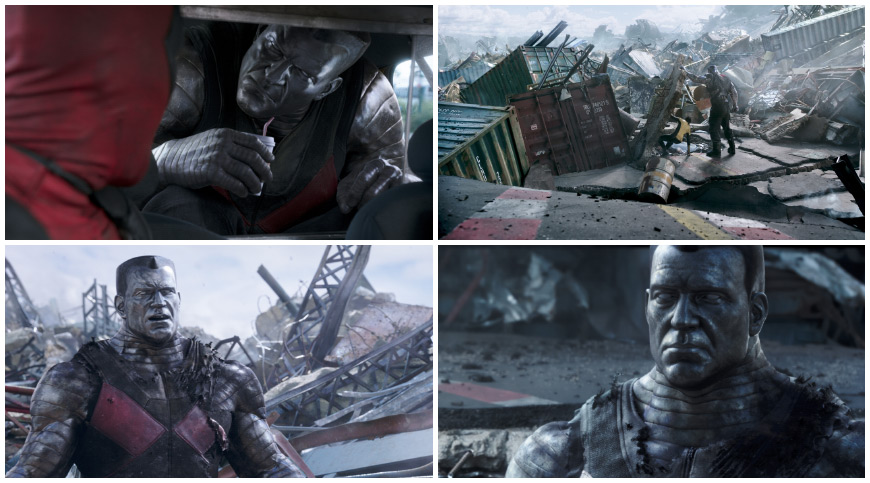
Image set: Visual effects shots produced by Blur Studio for the main film
Could you talk about the importance of timing in the sequence? It’s very rare that title designers or VFX artists really have to worry about something like comedic timing, but this sequence is just full of sight gags, jokes, and easter eggs. How did you handle that?
Franck: With lots of iteration. [laughs]
Tim: It was actually quite tricky. I’m not a comedic director at all, but it taught me a lot about comedy. During testing we had a version of the titles that was, let’s just say, less successful. The audience didn’t laugh as much and it really had a cooling effect on the first 10 or 15 minutes of the movie. People didn’t start laughing and so it was harder to get them laughing as we moved in deeper into the first act. It was surprising how much it affected the way the movie played!
We were trying to find the right balance. We weren’t going for big laughs, we were going for chuckles. So it was more of a reductive process. We had more jokes in there initially, but it felt cluttered. The audience spent so much time trying to decode what the jokes were that they didn’t enjoy the ones there. So we pulled it back.
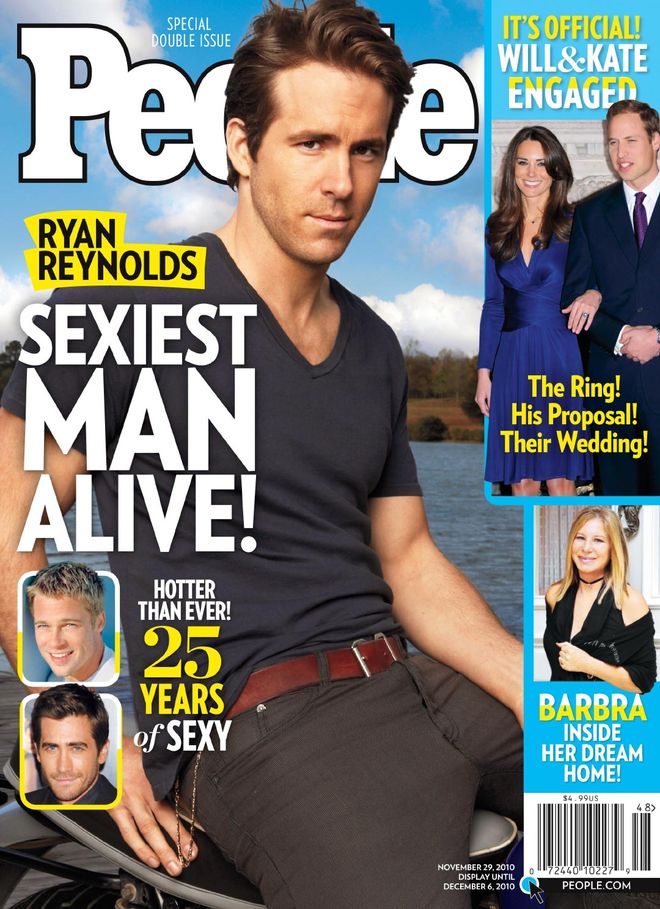
People magazine's 2010 "Sexiest Man Alive" issue featuring Deadpool star Ryan Reynolds
Franck: It has a lot to do with the pacing. The more you have on screen, the more your eyes are kind of moving around not knowing what to look at. So as Tim was saying, we removed about half the gags we had in there originally just to make sure people enjoyed the ones we wanted to hit. Then you need a beat on each one of them. The beats in between them, where you had nothing, were almost as important as the beats where you could see something, so that you would have that time to register. The screenings were actually a great tool to be able to see what made people laugh.
Tim: The screenings were so informative. You get to see when and where the audience laughs. And the magazine cover gets a huge laugh...
Franck: Only at a certain spot though!
Tim: It’s true. We had it later and it didn’t hit.
Franck: We had it earlier, but what we realized was that Ryan’s cover was kind of the moment everything shifted completely into meta, where people were like “Holy shit! This is a fake title sequence!” When we tried the cover later people were still trying to analyze the title sequence as if it was a real one and didn’t understand the jokes.
Tim: That was my bad idea. I thought since it was so abstract that we should let people get a sense of what was going on first. “Oh, I get it. It’s a car accident!” Give them time to realize it’s a frozen action moment – and then start hitting them with the jokes. Oddly enough that worked well for the comedy later on. It seems obvious, but I discovered that when people understand the plot they laugh easier. But for some reason that rule was reversed on the titles and showing the magazine earlier when things are still abstract worked best. As Franck said, it gives everyone permission to laugh and lets them know that the whole thing is going to be a joke.
Working with previs and VFX seemed to afford you a lot of freedom on this sequence. Were there ever any conversations about doing the opening as live action?
Franck: I’m sure Tim had that discussion at some point. “We can shoot those guys on wires and stuff!”
Tim: Coming out of the game cinematic world I was actually very comfortable with an all CG process. So we had quite a few discussions about how best to accomplish this piece. In a few places it doesn’t quite come off as photoreal, but because it’s the beginning of the movie you have some visual latitude. I believe the way we did it was the right way.

Image set: Main title sequence visual effects process examples
Franck: Yeah, ultimately even if we had wanted to do it in live action we couldn’t have because we started so late in the game. We barely had time to scan and properly photograph the stuntmen because they were already spread out across the world. The resolution we needed hadn’t been done as part of the main production.
But considering the amount of changes we had to do to make the timing work, The flexibility an all-CG approach allowed us was essential to be able to finish it in the time we had.
It must have helped that many of the 3D assets needed for the sequence had already been created by Atomic Fiction, the VFX company that worked on the freeway scene, right?
Franck: Absolutely. We got their assets, but we did need to rework them for a few reasons. The first was that we don’t use the same pipeline, so even if those assets were finished we would still have to convert them. The shaders are different, so there’s work to do there. In their sequence they didn’t need super high res assets because they never got that close to the characters. They were always wide shots or action shots, so you could get away with a lot of stuff. We started from what they sent us, but we rescanned the faces of most of the actors and up-res’d a lot of the assets.
Deadpool VFX reel by Atomic Fiction
Tim: It’s a similar pipeline for our game cinematics, where we get assets from the game that have been built for a different purpose. We have to adapt it to our purposes, which usually involves adding more detail. So it wasn’t a new process for us at all.
Let’s talk about some of the easter eggs in the sequence. Did it take any convincing to get Ryan Reynolds back into those green underoos?
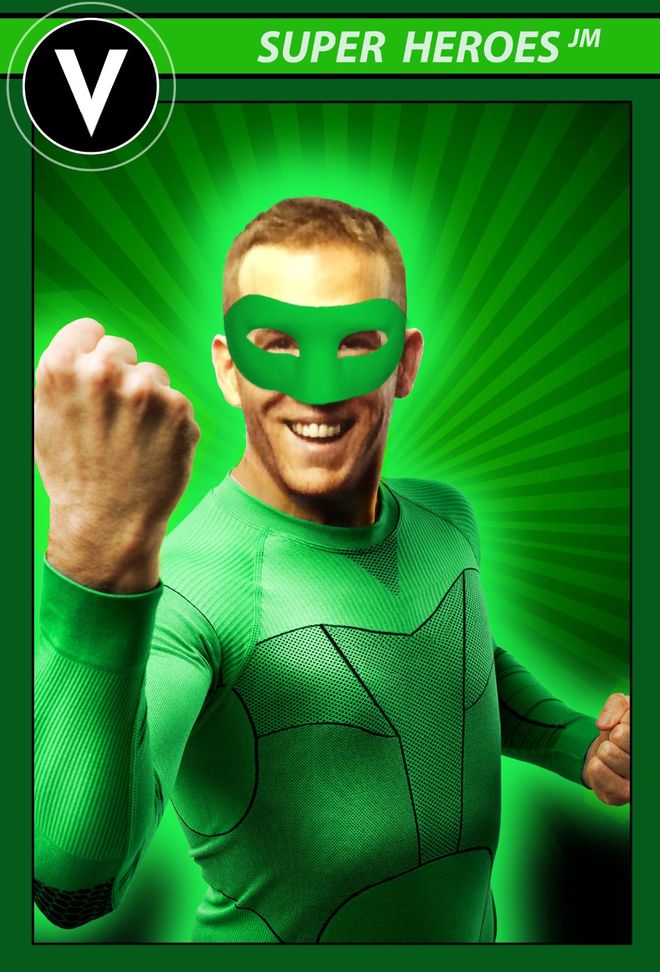
Tim: [laughs] Well, we actually bought a stock photo and put his face on it for that one...
Franck: The number of iterations on this card was insane! [laughs]
Tim: Yeah, it was a delicate situation. To find that sweet spot where it hinted at another film, but wasn’t that other film.
You’ve packed the sequence with great little nods for die hard Deadpool fans, but is there anything in there that people haven’t noticed yet?
Franck: Yeah, but I don’t think anyone will ever know. For instance, Doctor Killebrew is on the phone but it’s so out of focus that you never see it properly.
Tim: Yes, Doctor Killebrew is the guy in the comics that runs the Workshop.
Also the thug in the beginning with the lighter coming out of his mouth – we had a joke we filmed where Deadpool burns a circle in the middle of his forehead and says “I loved your work in Daredevil!” Colin Farrell was Bullseye in the Daredevil movie and he had a little target tattoo in the middle of his forehead. So that joke was something Ryan added as a fun insider gag originally, even though we eventually changed it to a broader joke, “I never say this, but don’t swallow!” [laughs]
Franck: We have Rob Liefeld on a coffee cup – Rob L. You have the little sex keychain as a little quick thing, you have the Ryan Reynolds cover, then you have the wallet that has Ryan Reynolds again, the Orange Number 5 card, the Hello Kitty, Deadpool’s junk, which is how we introduce the character…
Tim: That’s not quite an easter egg… As we said, we had more, but we took them out because it was confusing.
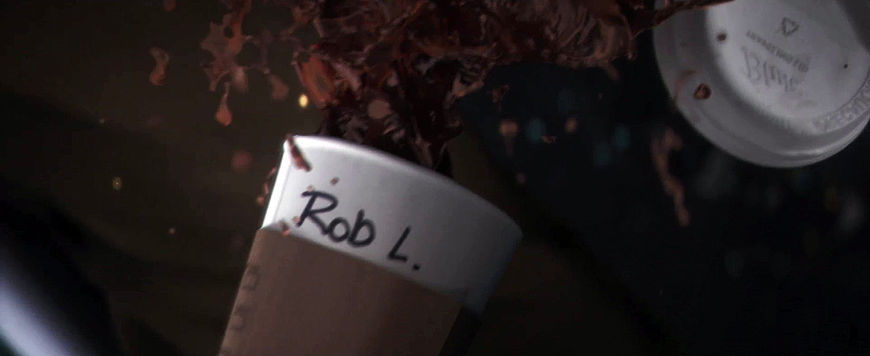
The "Rob L." easter egg is a reference to comic book artist and Deadpool co-creator Robert Liefeld.
Now I’ve got to ask you about the song choice: Juice Newton’s “Angel of the Morning”. Was the goal just to find the most antithetical piece of music to pair with all the murder and mayhem or what? Did you have any other songs in mind?
Tim: Juice Newton has been in there since day one. It was in the script. It was always in there. Other songs came and went, but that one never changed.
Franck: It was in the test footage as well.
Tim: The writers and Ryan are just a compendium of 80s and 90s pop music – they just love that shit! I think everybody gets a smile at the contrast of hardcore thugs off to commit murder and mayhem listening to Juice Newton. It gives them a sensitive side!
Juice Newton's "Angel of the Morning" music video
Tim: But "Angel of the Morning" was always in there. We had a couple of songs that were in the film until the last moment, like John Denver’s “I Want to Live”. We replaced it with Chicago’s “You're the inspiration” and “Mr. Sandman” during the torture montage!
[laughs] So is there any particular moment or element of this sequence are you most happy with?
Franck: For me it was introducing Deadpool by way of his junk. Originally Tim wasn’t really for that. [laughs] Tim was very attached to the original camera movement and the original way we were showing Deadpool. I suggested instead that we should start close, finish wide, it makes more sense and introduces Deadpool in the most irreverent way.

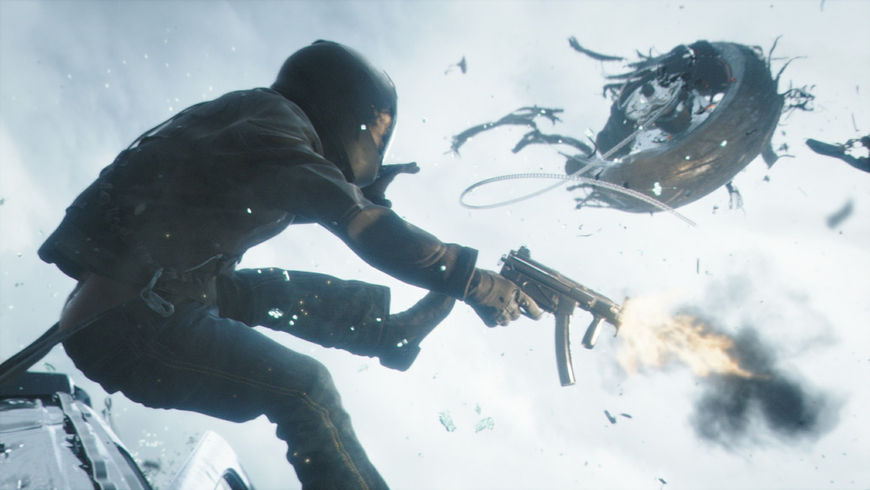
And of course the most spectacular wedgie ever put to film!
Tim: The wedgie is definitely a great moment! But mostly I love the way it starts, coming out of the abstract, glowing coils of the lighter. It’s a great opening beat.
So which tools and software were you using to put the opening together?
Franck: It was 3ds Max for most of it, like for layouts. For modelling, people use all kinds of software, ZBrush and that kind of stuff. We posed the characters using Softimage, just because we were going to get nicer deformation if we had to go in through the regular animation pipeline. But everything was handled in 3ds Max, rendered in V-Ray, and then composited in NUKE.
You cap off the film in perhaps the only way it could be capped off: Boners, ejaculating unicorns, and the sweet, sweet sounds of George Michael. Let’s talk about some of the initial concepts for the main-on-end titles.
Tim: [laughs] Jennifer [Miller], my wife, runs the design side and we decided we were going to do much simpler main-on-ends. She and Creative Director Norn Jordan came up with the concept for that. We worked with a few illustrators and designers who had a sense of humour, and between them they handled everything. I think the unicorn idea was Jennifer’s - it was really funny.
Deadpool (2016) main-on-end titles, directed by Jennifer Miller and Norn Jordan
But they had pitched a couple of great ideas that I was sorry we couldn’t do. There was a 1980s version of the titles, you know a Knight Rider-style version. They pitched doing our own version of the Honest Trailers, where the guys go in and tell you everything that was wrong with the movie. I loved that idea! We actually wanted to get the guy who does them to do an Honest Trailers version of Deadpool and run it during the titles. I can’t wait until they do one! [laughs]
I’m sure it’s only a matter of time! Do you feel like the superhero movie coda – the stinger after the credits – has helped revitalize the big screen title sequence to some degree? Putting the title sequence at the end was originally done to keep people in their seats for a coda. Did having the coda on your film immediately make you say, “Oh, we need an end title sequence too!”?
Franck: Well, if you’re going to spend the money and do something great, you want it as the appetizer instead of the dessert you have after 45 courses. But there’s so much going on in Deadpool that with the the end titles we felt it was better to clean your palate rather than add another scoop of extra stuff.
Tim: Maybe you’re right that they just do end credits to keep people in their seats – but honestly that’s never occurred to me. I figured they did it for the same reason I’m usually a fan of end credits, which is that you get into the story faster up front without titles.
Franck: That’s the thing. In Deadpool it’s part of the movie, not just a title sequence with letters on black for a minute and a half. Please start the movie!
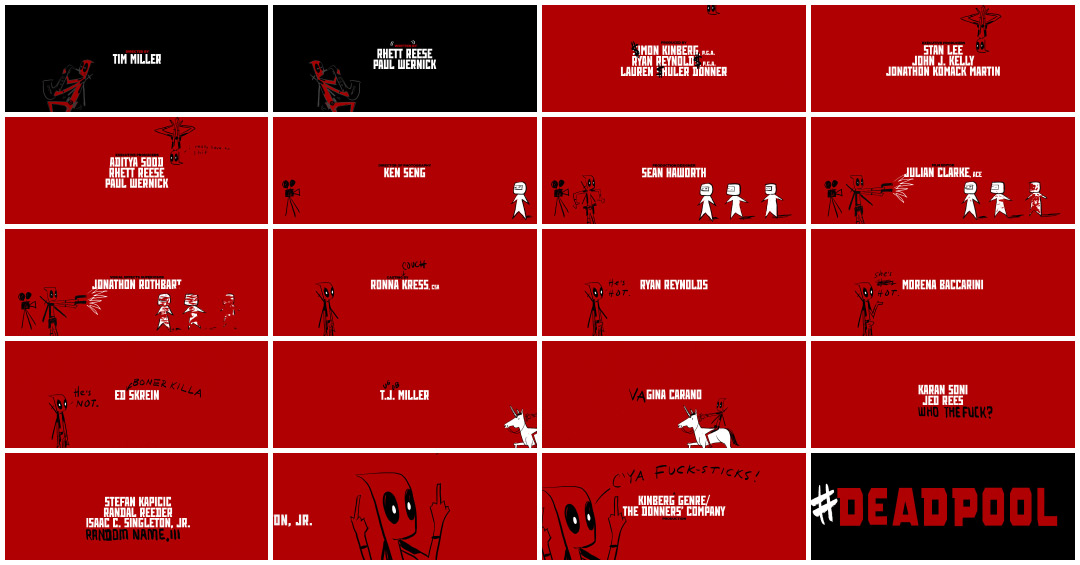
Early designs for the Deadpool main-on-end title sequence, designed and illustrated by Justin Claus Harder
Tim: Maybe that was the genesis of it – but I think that directors are probably more interested in getting into the movie, which means the main titles have to go somewhere and there’s only one place to put them. And even if you have the main titles at the back, you still have a long credits crawl that people have to wait through to get to a coda. So it’s only of marginal value.
Fair enough. It’s certainly a trend that we’re happy to see.
Tim: But I have to say, that our coda is a great moment for me. I have such a fucking pet peeve about people leaving their trash in the theatre. I don’t know when it became socially permissible to just leave your trash laying around. It sends me into a rage every time I go to the movies, the lights come up, and we walk out through piles of garbage. So when we did our coda I said to Rhett and Paul Wernick, “Alright, we’ve got to do something about this!” So we put a few lines in there and fuck it makes me feel good!
[laughs] I know the ushers at the screening I went to had huge smiles on their faces when that came on. It was so great to see.
Tim: [laughs] Yeah, I thought, “theatre attendants across America are going to appreciate this!”
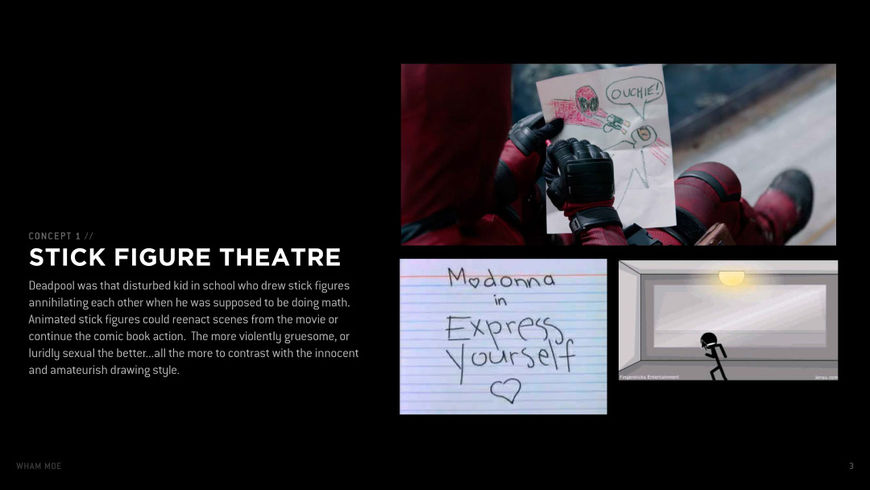
Image set: Alternate end credits concepts
So Tim, you and folks like Joseph Kosinski, Gareth Edwards, and Henry Hobson are part of a wave of feature filmmakers coming out of the VFX and title design industries. It’s great to see! Is there something about title design or this kind of storytelling that you think prepared you to make the jump to feature films?
Tim: I don’t know if I’d say that necessarily, but I would say that my background helped me in a lot of areas. Like I said, I think this is a lightning strike, so I don’t want to be like “Yes, I’ve been planning for this exact thing my entire life!” But here at Blur we’ve always been more than a service company – clients come to us and we write and direct much of what we do. I feel like my story background really helped me first and foremost. But secondly, running a company is very much like being on a set and my experience at Blur is a huge help. Blur has anywhere from 90 to 150 people at any given time and most of them are artists; so I need to get everyone moving in the same direction without hating me. A film set has a lot in common, many very talented people with their own ideas. It was useful to have experience in making decisions, managing people and getting everyone headed in the same direction.
And my experience as an animator was also helpful. We’re constantly doing all-CG work– constantly trying to recreate reality – and you become a student of the nuances of how people actually move in real life. So later on you can inject that into the all CG process. That really helped me on set. Every day we start the process of shooting a scene by blocking it out – this is working out how the actors will move through the scene and deliver dialogue so that it feels natural. For me, having done mocap, being attuned to animation and how people move really helped me with the actors and discovering the most organic way work out the scene. How should it sound? What feels right? An animation background really helped with that.
DC Universe Online (2011) opening cinematic, produced by Blur and directed by Tim Miller
Tim: Those are the biggest things. But people take a lots of different paths to directing. You can very rarely go right into that, so you’ve got to do something else first. Whatever else you do first will likely, in some way, apply to directing films. Because it’s not just a singular skill, it’s a whole bunch of skills that you can do well or less well.
But whether it’s title design or game cinematics or a film, your job as a director is to marshal the skills of all these other talented people to whatever vision you have for the project. We get a lot of practice with that here. I used to do the same thing Franck does now. In the early days of Blur I was more involved in the animatics because that’s where the rubber hits the road and you find out if the story works.
For both of you, what are some of your personal favourite title sequences, either classic or contemporary?
Tim: [long pause] Thor 2. The Girl with the Dragon Tattoo… [laughs]
[laughs] I hear good things about that one…
Franck: I actually really like the one from Zombieland. It just so happens to be from the same writers [as Deadpool].
Zombieland (2009) main titles, designed by Ben Conrad
Tim: I really like the True Detective season one sequence. Game of Thrones and Vikings.
Television is where all the action really seems to be happening in titles these days.
Franck: TV shows are getting great title sequences now. The Jessica Jones one is really well made, it was really nice. Those TV series’ are basically movies now. They look as polished as movies. I mean, Game of Thrones, the visual quality that they have for everything – visual effects, acting, lighting, costumes – it’s movie quality but in a longer format that allows you to tell more stories and develop the characters even more.
Tim: But what it does lack is scope. You’re not going to see the big battle sequences like you see in Gladiator. You do get to have a great title sequence though – that’s two minutes of content you don’t have to create every week!
Game of Thrones (2011) main titles, directed by Angus Wall
What have you seen or watched lately that’s been exciting to you?
Tim: I just finished Mark Millar’s Jupiter’s Legacy and Huck, two of his that I really like. I’m a huge Marvel fan and a big Brian Michael Bendis fan and I read Powers religiously, I really like Lazarus too from Image. It’s a great comic.
And I know I’m late to the party, but I’m almost through Friday Night Lights and loving it. What else? The Revenant was pretty amazing.
Franck: I haven’t seen it.
Tim: You haven’t seen it?
Franck: I’ve been working!
Tim: You’ve gotta see it.
Franck: I went to see Deadpool! [laughs]
